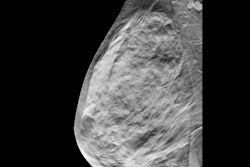
A study from Canada indicates that women in their 40s who received mammography screening had lower rates of advanced disease and breast cancer mortality compared with women whose cancer was detected when symptomatic, according to a presentation at the Society of Breast Imaging meeting.
Women ages 40 to 49 who participated in screening had a 41% reduction in their risk of death from breast cancer, compared with women who did not get screened and whose cancers were detected when symptomatic. Women whose cancers were detected when symptomatic also required more extensive treatment.
The findings emphasize the importance of screening younger women, who often present with symptomatic, advanced disease, presenter Dr. Jean Seely of the University of Ottawa in Ontario, Canada, told session attendees.
Breast screening for women in their 40s has generated controversy, in particular after the U.S Preventive Services Task Force in 2009 declined to recommend breast screening for these women. Most breast imaging and women's health groups continue to advise screening for these younger women.
In Canada, the Canadian Task Force on Preventive Health Care (CTFPHC) does not recommend mammography screening for women in their 40s. Seely believes this stance does a disservice to younger women.
"The Canadian Task Force on Preventive Health Care guidelines for breast cancer screening in women 40 to 49 years led to higher [death rates] and more extensive treatments in women not detected at an early stage with screening mammography," she said. "Women 40 years and older should be allowed to benefit from early detection of breast cancer through screening mammography."
Current CTFPHC guidelines recommend screening women between the ages of 50 and 74 every two to three years and state that women between the ages of 40 and 49 should not be routinely screened. The task force does not have a recommendation for women 75 and older, Seely noted.
How do these recommendations affect women who are outside the CTFPHC's set screening ages? Seely and colleagues sought to assess the impact of these guidelines on tumor stage, treatment, and mortality of women 40 years and older via a study that included 822 women diagnosed with breast cancer in 2016.
They explored the effect of age, method of detection (screen, symptomatic, or incidental), tissue density, pathologic state, tumor histology, hormone receptor status, treatment, and tracked mortality rates at four-year follow-up.
Of the 822 women, 84.8% had invasive cancer and 15.2% had ductal carcinoma in situ (DCIS). At four-year follow-up, 6.2% of the women had died from breast cancer.
Seely's team noted that, of the detected cancers, the women whose cancers were detected by screening tended to be at an earlier stage. The group also found that women who did not receive screening tended to present with more advanced, symptomatic breast cancer -- which led to higher mortality rates compared with those who underwent regular screening.
| Symptomatic vs. screen-detected cancers in women in their 40s | ||
| Measure | Cancers detected when symptomatic | Cancers detected on screening |
| Early-stage cancers | 26% | 80% |
| Odds of advanced-stage cancer | 7.04 | 1.0 |
| Odds of death (adjusted for age) | 3.36 | 1.0 |
| Percent of breast cancer deaths in total cohort | 6.77% | 0% |
| Percent of mastectomies | 29.32% | 10.53% |
What do these findings indicate? Not screening women younger than 50 and older than 75 leads to poor outcomes for these cohorts, Seely concluded.
"Our study showed significantly more early-stage breast cancers in the screen-detected than the symptomatically detected breast cancers, and fewer deaths and less aggressive treatment," she said. "This corroborates other studies [that show] that mammography screening reduces the risk of advanced and fatal breast cancers."




















